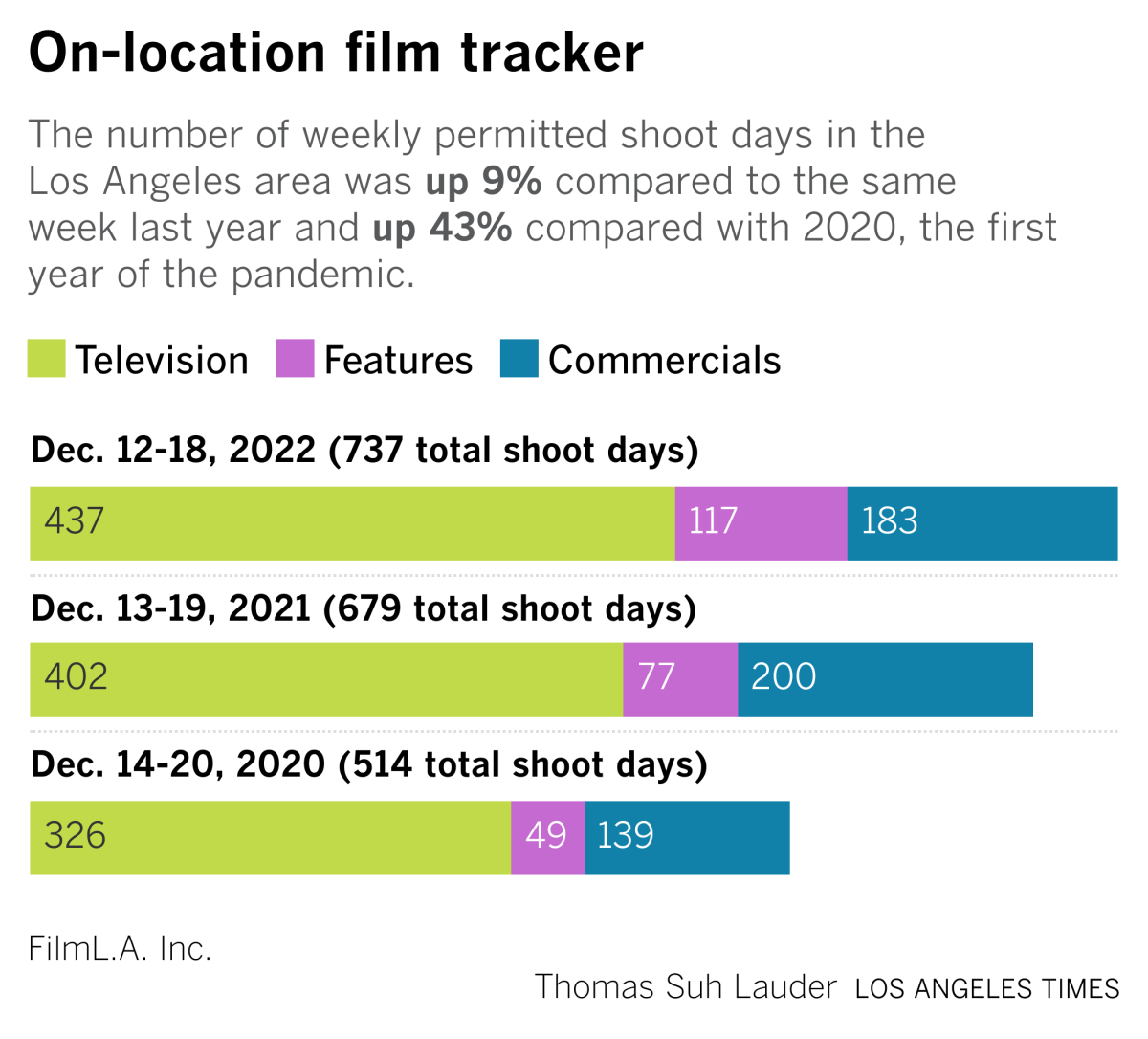It’s not just you. There’s too much TV and studios know it

- Share via
Welcome to the Wide Shot, a newsletter about the business of entertainment. Sign up here to get it in your inbox.
As we get to the end of the year, I want to say thank you to all of you Wide Shot subscribers, especially those who’ve been writing in with feedback week after week. It’s greatly appreciated, and it makes our coverage better. A special shoutout to all you grown adults sneaking cookies for breakfast during the next couple weeks.
Shameless plug department: I discussed my top 10 Hollywood fiascoes with Sonny Bunch on his Bulwark Goes to Hollywood podcast.
Debating the future of entertainment
Anousha Sakoui and I hosted six high-level entertainment industry executives for our Company Town panel to discuss big questions about the future of movies, TV and streaming. Here are the top five takeaways.

It turns out, there is such a thing as “too much TV.”
If you think the number of “must-watch” shows and movies on streaming services is overwhelming, just ask the people who create them what they think. Even the studios think it’s too much.
The “peak TV” era is often touted as a harvest time for producers, and yes, there’s plenty of money to be made from selling shows to ravenous streamers. There were a record 559 original scripted programs in 2021, according to FX’s annual calculations.
“What you see is that these companies, even if they are in flux, for the most part, these are very large spends and commitments into content,” said Creative Artists Agency President Jim Burtson. “And from where we sit right now, it’s still really robust.”
But the glut of streaming content is not an unmitigated good for studios, filmmakers or viewers. The prospect for creating long-term value from those productions is complicated by the fact that much of what gets produced then becomes lost in the limitless space of the streaming services’ ever-rotating carousels. Stacey Snider, co-founder and chief executive of production company Sister, said her big worry is about “discoverability” of content.
“Valuable content is content for which there’s an affinity, where you can build community, where people can really experience it and talk about it,” she said. “And that’s what has always made the libraries of the studios really valuable. It’s not volume, it’s familiarity and affinity. And so I do worry that, with the volume and with the split attention, that the opportunity for that close connection between the audience and the creative work is harder to build.”
Artists want skin in the game.
Streaming services are notorious for their talent deals, which tend to buy out rights and projected back-end profits upfront, globally and in perpetuity. That often guarantees a big, safe payday for producers.
It also, however, limits how creators can participate financially in the success of their creations. It thus puts a cap on the value studios can create from their shows and changes the incentives for filmmakers, our panelists said.
“I wish that the studios and the distributors and the streamers recognized also that when creators have skin in the game, their work shifts,” said Snider, who previously ran 20th Century Fox Film. “It just does. I’ve been on both sides of it now.”
Not everyone in the business thinks this way, but clearly some want the streaming model to start rewarding them for their wins, perhaps by establishing bonuses based on viewership and allowing producers to retain ownership and certain rights.
“There’s a lot that the streamers are trying to figure out right now,” said Blumhouse President Abhijay Prakash. “And now what’s next? We like to bet on upside, bet on ourselves, right? Make the content, film or TV, for the lowest price possible and then participate in the wins. And that model doesn’t really exist in streaming.”
Traditional linear TV is declining but still valuable.
Bob Iger may believe the regular TV business is headed off a cliff. But let’s not mistake an eroding business for a worthless one.
“For us, it still plays a huge role,” said Nina L. Diaz, of Paramount Media Networks and MTV Entertainment Studios, who touted Paramount shows like “Yellowstone” and “Love & Hip-Hop.” “It’s a great platform to market and launch onto other platforms like Pluto and Paramount+. We’re fortunate enough to own our own IP and have a huge catalog that is based on our linear business.”
Sony Pictures Chairman and Chief Executive Tony Vinciquerra took the idea further.
“Linear is still the majority of viewing today,” he said. “It’s obviously on a downslope and streaming on an upslope, but it ain’t going anywhere soon. The No. 1 show on television is the NFL. No. 2 show on television is ‘Jeopardy!,’ believe it or not. People still watch local news every day. It is diminishing, but not at the rate that people seem to really assume it is.”
Streaming services will consolidate.
This has been predicted since the streaming wars began in earnest in late 2019 with the launches of Disney+ and Apple TV+.
Studios and production companies — at least the “arms dealers” selling their product to third parties — hope the pull-back doesn’t happen too fast.
“Consolidation is going to continue, there’s no doubt,” Vinciquerra said. “There won’t be as many streaming services in five years as there are today. They’re all fighting for subscribers right now, and that will continue for, hopefully, three, maybe four years.”
Flexible theatrical windows are here to stay.
The adoption of variable theatrical windows is something that studios wanted for years but met with staunch resistance from theaters, until the pandemic allowed distributors to force the issue.
Studio heads say the new model is more sustainable, profitable and efficient, allowing them to adjust the length of time their movies spend in theaters, depending on whether audiences are showing up.
The theater business is not going anywhere. It’s just changing and adapting.
Box office is an uncertain business and always has been. But it remains extremely profitable for the right kinds of movies, even certain midbudget adult-oriented ones (“The Woman King”). It’s also good marketing, as even Netflix knows.
“If you can get into the theaters, you get the benefit of theatrical exposure, plus downstream money that comes from streamers, or you start on the streamers, and that’s a great place to find an audience for certain kinds of movies,” said Prakash. “So if you calibrate it right, it’s a really great time to be producing.”
“But that’s the biggest thing, you have to calibrate it right,” added Charles D. King, founder and chief executive of Macro. “You make sure to hold them in theaters just long enough to really maximize the value.”
Stuff we wrote
Animation by Erik Carter / For The Times; video by Steevy Areeco, Jennifer Bryant and Angela Sharbino
— Who’s protecting social media’s child stars? Inside the explosive lawsuit against one YouTuber’s empire,
— I, Robot. A.I. is here, and it’s making movies. Is Hollywood ready?
— Epic Games hit with record $520 million in penalties over Fortnite privacy breaches. The popular game duped millions of players into making unintentional purchases, the Federal Trade Commission said.
— Former CNN chief Jeff Zucker to lead $1-billion media investment group. The veteran executive has been named chief executive and operating partner of RedBird IMI.
— Tough break for Henry Cavill. It turns out that it was a little premature of him to announce his return as Superman right before a major DC regime change.
— ICYMI. IMDb changes policies, ending age discrimination fight with SAG-AFTRA. ‘GMA3’ hosts Amy Robach and T.J. Holmes ‘will remain off-air’ pending internal review. Fox News’ ‘The Five’ topples ‘Tucker Carlson Tonight’ to become new cable news ratings leader.
Number of the week

The opening weekend box office for “Avatar: The Way of Water” — $134 million domestic and $307.6 million overseas — came in lower than expectations. Analysts had been predicting $150 million to $175 million from the U.S. and Canada.
But let’s calm down.
This movie’s success is not just about the debut, it’s about the long game, just as it was for the first “Avatar” in 2009 when it opened at $77 million in the U.S. and Canada and eventually made its way to $2.7 billion worldwide ($2.9 billion after re-releases).
The new film faces minimal competition in the coming weeks, the audience scores are high and Cameron’s movies typically have strong legs. Maybe people who couldn’t get tickets for 3-D screenings chose to wait? 3-D represented 57% of domestic business for the “Avatar” sequel.
This isn’t the same movie business that existed in 2009, though, and we won’t really know how the film’s performance is shaping up until next weekend. Cameron himself has suggested that the target for the film is roughly $2 billion worldwide.
Analyst David A. Gross, of Franchise Entertainment Research, estimates that the actual break-even point is much lower. Either way, Disney has a lot on the line here, with three additional sequels on the way. Credit Cameron for aiming high.
“Ultimately, the Avatar series is going to be profitable, it’s going to feed all of Disney’s businesses, and the next film is on its way,” Gross wrote in his Sunday dispatch.
China was an issue for “The Way of Water,” falling short of projections with its $57-million opening weekend despite strong social media scores. Renewed optimism for the China box office after the easing of COVID-19 restrictions was hampered by coronavirus outbreaks in the country. The first “Avatar” made more than $200 million there during its original release, so this is an important market.
Rance Pow, of the box office data firm Artisan Gateway, notes that “The Way of Water” faces minimal competition until the Chinese New Year release of the “Wandering Earth” sequel. But the damage wrought by the virus makes forecasting difficult. “It is a bumpy path to recovery in China, perhaps more so now than in any other major theatrical market worldwide,” Pow said in an email.
Best of the web
— ‘Gangnam Style’ brought K-Pop to the world, but haunted its creator. (New York Times)
— How effective altruism let Sam Bankman-Fried and FTX happen. (Vox)
— All these retail workers want for Christmas is to stop that Mariah Carey song. (Wall Street Journal)
— ‘White Lotus’ didn’t care about toxic masculinity after all. (NYT)
Film shoots
FilmLA reports solid weekly production numbers as the industry heads to the end of the year. Shoot days were up from the previous week and the same period a year ago.


Finally ...
One of my favorite things to do every December is binge the best stand-up comedy albums and specials of the year, as determined by our paper, NPR’s “Bullseye With Jesse Thorn” and Paste. My favorite find so far: Canadian comic Luba Magnus’ delightfully silly “Baba Luba.” Spike that eggnog and enjoy her reminiscences of not being allowed to watch “Dawson’s Creek.”
Inside the business of entertainment
The Wide Shot brings you news, analysis and insights on everything from streaming wars to production — and what it all means for the future.
You may occasionally receive promotional content from the Los Angeles Times.




